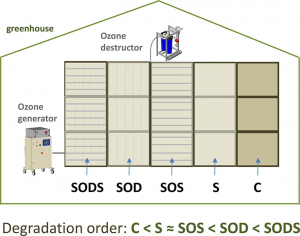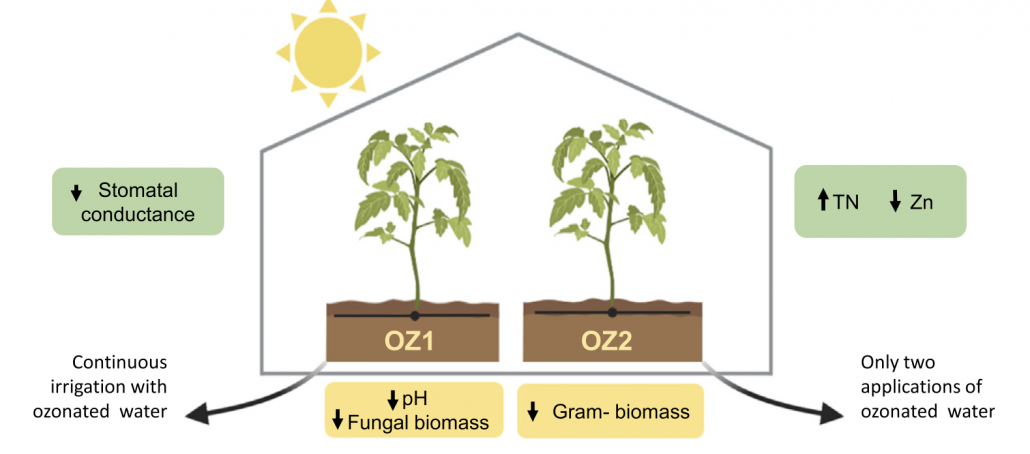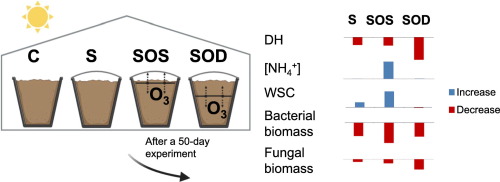February 2023
C.M. Martinez-Escudero, I. Garrido, C. Ros, P. Flores, P. Hellín, F. Contreras, J. Fenoll
Abstract
Soil contamination by pesticides is a growing environmental problem. Even though nowadays numerous soil remediation technologies are available, most of them have not been tested at field scale. This study attempts to demonstrate the efficiency of solarization-ozonation techniques for the removal of twelve pesticides at full scale. Initial solarization and ozonation trials were conducted in plots located in a greenhouse using freshly and aged contaminated soils under controlled pilot conditions. The combination of solarization and ozonation treatment was efficient for all the studied pesticides both in freshly and in aged contaminated soils, being the lower degradation values found for the second type. This low removal suggests that the increase of pesticides’ adsorption on soil resulting from ageing decreases their availability. Once the essays were carried out at pilot scale, the solarization-ozonation applicability was evaluated in a commercial farm soil. This trial was carried out in a greenhouse whose soil had previously been contaminated with some of the pesticides studied. A significant degradation (53.8%) was observed after 40 days of treatment. Pesticides’ main metabolites were identified during the different remediation experiments. In addition, the cost of the combined solarization and ozonation technology was evaluated. Finally, our results suggest that this combination of techniques could be considered a promising technology to degrade pesticides in soil.

May 2022
C.M.Martínez, I.Garrido, P.Flores, P.Hellín, F.Contreras, J.Fenoll
Abstract
This work is the first ever study under field conditions for the removal of different classes of pesticides from soil using ozonation as a remediation technique. Initial assays were conducted with three different soil matrices to assess the effectiveness of the methodology under lab conditions. Field scale experiments were carried out on plots located in a greenhouse during the winter of 2020. The polluted soil was exposed to different treatments to test the effect of the mode of ozone application on pesticide degradation (S: polyethylene film covering, SOS: polyethylene film + surface ozone application, SOD: polyethylene film + deep application, SODS: polyethylene film + dual application, and C: no treatment). Ozonation impact was also assessed by variations on physical–chemical characteristics of the soil. Higher degradation was detected in ozonized soils, particularly in the SODS treatment, where ozone was dually applied on the surface and deep. During monitoring of remediation experiments, 15 of the main transformation products (TPs) were found. The results suggest that ozonation has favourable prospects to be considered a credible alternative technology for remediation of pesticide polluted soils.

February 2022
C.M.Martínez-Escudero, I.Garrido, P.Flores, P.Hellín, F.Contreras-López, J.Fenoll
Abstract
This study aimed to investigate the effectiveness of ozonation and solarization techniques for the removal of different types of pesticides from soil during the summer season. The effect of two experimental parameters (temperature and ozone application mode) on the pesticide degradation was evaluated. The results showed that solarization (S), solarization with surface ozonation (SOS), and solarization with deep ozonation (SOD) enhanced pesticide degradation rates in comparison with the control (untreated soil, C). The triazole, anilinopyrimidine, strobilurin and neonicotinoid pesticides showed similar behaviour under S and SOS conditions. The highest decrease was found in SOD, indicating the significant effect of temperature and ozone application mode on the efficiency of the ozonation treatment. Thus, a higher soil temperature and a longer accumulated time at high temperature in treatments S, SOS and SOD were observed due to solarization process. In addition, the removal efficiency was enhanced with exposure time. Finally, the main 15 transformation products were identified during SOD treatment. The results suggest that solarization combined with ozonation techniques allows decontamination of soil containing pesticide residues.

November 2021
Marta Díaz-López , José A. Siles, Caridad Ros, Felipe Bastida, Emilio Nicolás
Abstract
Ozone has been applied in many processes (drinking water disinfection and wastewater treatment, among others) based on its high degree of effectiveness as a wide-spectrum disinfectant and its potential for the degra- dation of pollutants and pesticides. Nevertheless, the effects of irrigation with ozonated water on the soil micro- bial community and plant physiology and productivity at the field scale are largely unknown. Here, we assessed the impact of irrigation with ozonated water on the microbial community of a Mediterranean soil and on Solanum lycopersicum L. agro-physiology and productivity in a greenhouse experiment. For this purpose, we evaluated: i) soil physicochemical properties, soil enzyme activities, and the biomass (through analysis of microbial fatty acids) and diversity (through 16S rRNA gene and ITS2 amplicon sequencing) of the soil microbial community, and ii) the nutrient content, physiology, yield, and fruit quality of tomato plants. Overall, the soil physicochemical properties were slightly affected by the treatments applied, showing some differences between continuous and intermittent irrigation with ozonated water. Only the soil pH was significantly reduced by continuous irrigation with ozonated water at the end of the assay. Biochemical parameters (enzymatic activities) showed no signifi- cant differences between the treatments studied. The biomasses of Gram- bacteria and fungi were decreased by intermittent and continuous irrigation with ozonated water, respectively. However, the diversity, structure, and composition of the soil microbial community were not affected by the ozone treatments. Changes in soil properties slightly affected tomato plant physiology but did not affect yield or fruit quality. The stomatal conduc- tance was reduced and the intrinsic water use efficiency was increased by continuous irrigation with ozonated water. Our results suggest that soil health and fertility were not compromised, however ozonated water treat- ments should be tailored to individual crop conditions to avoid adverse effects.

March 2021
More information click here
Marta Díaz-López Emilio Nicolás Rubén López-Mondéjar Lucas Galera Isabel Garrido José Fenoll Felipe Bastida
Abstract
Pesticides have been used extensively in agriculture to control pests and soil-borne diseases. Most of these pesticides can persist in soil in harmful concentrations due to their intrinsic characteristics and their interactions with soil. Soil solarization has been demonstrated to enhance pesticide degradation under field conditions. Recently, ozonation has been suggested as a feasible method for reducing the pesticide load in agricultural fields. However, the effects of ozonation in the soil microbial community have not been studied so far. Here, we evaluate the combined effects of solarization and ozonation on the microbial community of a Mediterranean soil. For this purpose, soil physico-chemical characteristics and enzyme activities and the biomass (through analysis of microbial fatty acids) and diversity (through 16S rRNA and ITS amplicon sequencing) of soil microbial communities were analyzed in a 50-day greenhouse experiment. The degradation of the pesticides was increased by 20%, 28%, and 33% in solarized soil (S), solarized soil with surface ozonation (SOS), and solarized soil with deep ozonation (SOD), respectively, in comparison to control (untreated) soil. Solarization and its combination with ozonation (SOS and SOD) increased the ammonium content as well as the electrical conductivity, while enzyme activities and soil microbial biomass were negatively affected. Despite the biocidal character of ozone, several microbial populations with demonstrated pesticide-degradation capacity showed increases in their relative abundance. Overall, the combination of solarization plus ozone did not exacerbate the effects of solarization on the soil chemistry and microbial communities, but did improve pesticide degradation.


